85% of consumers say they trust user-generated content more than anything a brand creates itself. So, if you're still relying solely on polished ads or studio shoots to build trust, you’re already a step behind.
Nowadays, most agile brands are scaling UGC to fuel high-performing ads, drive conversions, and gain customer trust across every touchpoint.
This guide breaks down everything you need to know to start using UGC creators the right way and avoid the common pitfalls.
Here’s what we’ll cover:
P.S. Tired of ads that don’t feel native? You don’t need more studio shoots. You need better creative inputs. UGC-first agencies like inBeat can help you scale authentic, high-performing content with vetted creators, rapid testing, and full creative oversight, without burning out your internal team.
Book a free strategy call now and see how real content can drive real results.
UGC creators produce customer-style content such as product demos, reviews, and unboxings designed for ad performance and brand trust.
Unlike influencers, they create content for brands to publish, with no need to post to personal channels or maintain an audience.
Key benefits include lower content costs, higher engagement rates, improved social proof, and stronger brand credibility.
Risks to manage include creator alignment issues, unclear usage rights, and potential legal challenges without proper contracts or briefs.
You can collaborate with creators via talent platforms, internal teams (employees or customers), repurposed social content, or specialized UGC agencies like inBeat.
Typical rates range from $150–$300 per video in the U.S., with variation based on region, creator skill, and scope of work.
Top-performing creators understand marketing structure, follow direction well, present naturally on camera, and optimize for performance.
New creators should choose a clear niche, research successful formats, build a small content portfolio, and connect with active brands.
Follower count is unnecessary since brands use UGC in their own campaigns rather than relying on a creator’s reach.
inBeat Agency helps brands find reliable creators, manage content at scale, and deliver assets tailored for conversion.
A user-generated content (UGC) creator is someone who produces authentic-looking content that feels like it came from a real customer. They create short videos or photos showing product demos, unboxings, or casual reviews.
Unlike influencers, they don’t need to post anything themselves. Brands use their content on paid ads, landing pages, and social media to drive trust and clicks. It looks organic, but it's designed to convert, and it often outperforms traditional branded content.
For example, UGC creator Matt Upham created a high-performing TikTok for Unroll.me in partnership with inBeat Agency. You can see it’s simple, relatable, and built for scroll-stopping engagement.
Here’s where most people get confused.
A UGC creator is paid to create content, not to post it. That means no audience is required. They focus on making videos that feel real and relatable, as well as ads, reviews, and unboxings that you can use across social media and paid campaigns.
An influencer gets paid for reach. You’re renting their audience and hoping their followers engage.
An affiliate earns a commission based on results. They might share a link and only get paid if it converts.
An actor delivers a polished, scripted performance, usually for TV spots or high-production brand videos.
Each role has its place, but for brands that want authentic content that performs, UGC creators are hard to beat.

UGC creators create content that looks organic but is built with intention. They focus on short videos and photos that brands can plug into social media, ad campaigns, or landing pages. This could mean filming tutorials, testimonials, or product unboxings from their phone, or setting up clean still shots for a new launch.
Some follow a detailed script, while others bring their own voice while still adhering to the creative brief. Once the content is ready, they deliver raw or polished assets, and the brand can start using them right away.
If you're exploring user-generated content for your next marketing initiative, it's important to understand the benefits and potential risks upfront.
Below are the key factors to consider before bringing UGC creators into the mix.
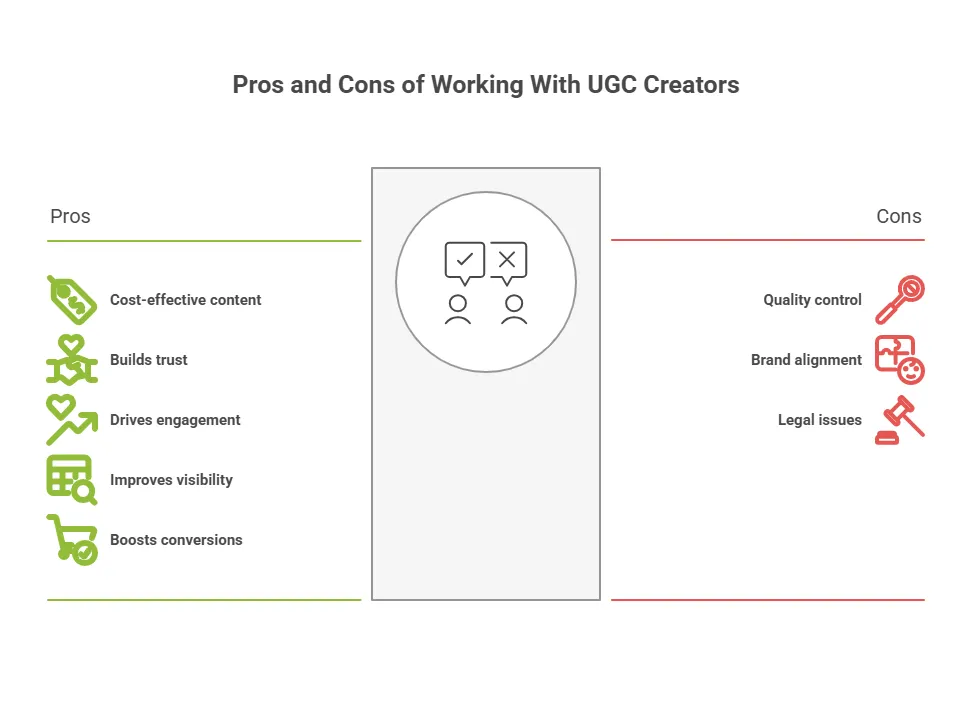
Let’s break down the biggest advantages of working with UGC creators, backed by real numbers and results.
Working with UGC creators gives you high-impact content without the high-end production price. You can save an average of $72,000 a year by leaning on agile creator partnerships instead of building full in-house content teams.
One of the biggest perks of working with UGC creators? Their content feels human. That authenticity is a huge win: 60% of consumers say UGC is the most genuine type of brand content they come across, and millennials find it 2.4x more authentic than polished brand promos. When real people share real stories, it hits differently.
UGC creators know how to make content click. Their posts often outperform polished brand ads, especially on platforms like TikTok and Instagram Reels. When you tap into UGC, you can see up to a 50% increase in engagement, and ads using creator content deliver 4x higher click-through rates while cutting cost-per-click by 50%.
UGC creators help you build trust where it counts, from scroll-stopping ads to high-converting product pages. About 79% of shoppers say UGC plays a major role in their buying decisions, and adding it to key touchpoints can increase conversions by up to 10%.
Real voices build real relationships. 75% of marketers believe user-generated content makes their brand feel more trustworthy. That kind of credibility leads to repeat purchases, stronger community engagement, and long-term brand loyalty. These are the outcomes most brands chase, whether they work with UGC creators or not.
UGC creators can bring speed and authenticity to your content strategy. But there are a few risks worth keeping on your radar, especially if you're planning to scale fast or use content across multiple brand channels.
Not every creator will align with your brand messaging. Without a strong screening process, you could end up with visuals that feel off-brand or don’t match your tone. That’s why campaign management and clear creative briefs matter more than ever.
Agencies like inBeat give creators detailed briefs to remove any confusion. They outline exactly what can and can’t be said, what tone to follow, and what visuals to avoid.
Here’s an example of their detailed brief created for Brave (scroll-stopping, clear, and creator-friendly):
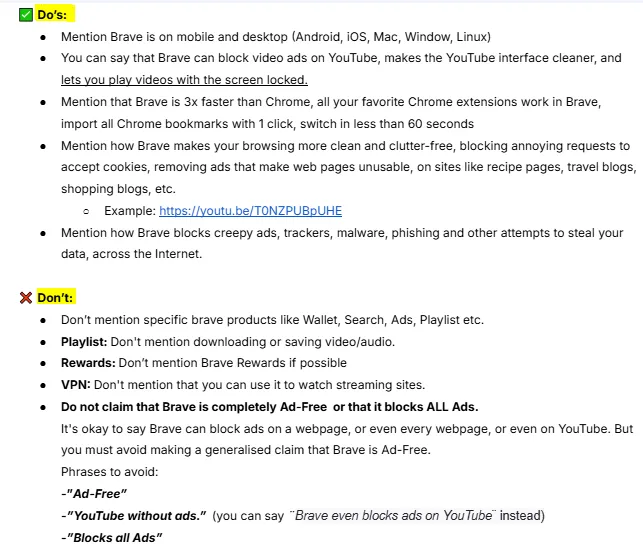
Repurposing creator content for paid ads, email marketing, or digital signage requires well-defined content ownership. If UGC contracts aren’t clear, it can create friction down the line, especially when investing in multi-platform campaigns.
Some creators use trending sounds, exaggerate product claims, or skip required disclosures. If you’re not careful, this opens your brand to copyright issues or compliance problems. Paid UGC creators should always follow platform rules, industry guidelines, and brand-specific guardrails.
One real example: in 2020, the FTC took action against a wellness brand called Teami for making false health claims and using paid influencers who didn’t properly disclose their sponsorships. The brand promoted detox teas as treatments for weight loss, migraines, and even cancer, without credible evidence.
Influencers posted about the products, but disclosures were buried or missing. The company ended up refunding over $930,000 to consumers.
While this case involved influencers, the same legal standards apply to paid UGC creators, especially when their content is used in brand ads or across social media platforms. If the messaging is misleading or improperly disclosed, both the brand and the creator can be held accountable.
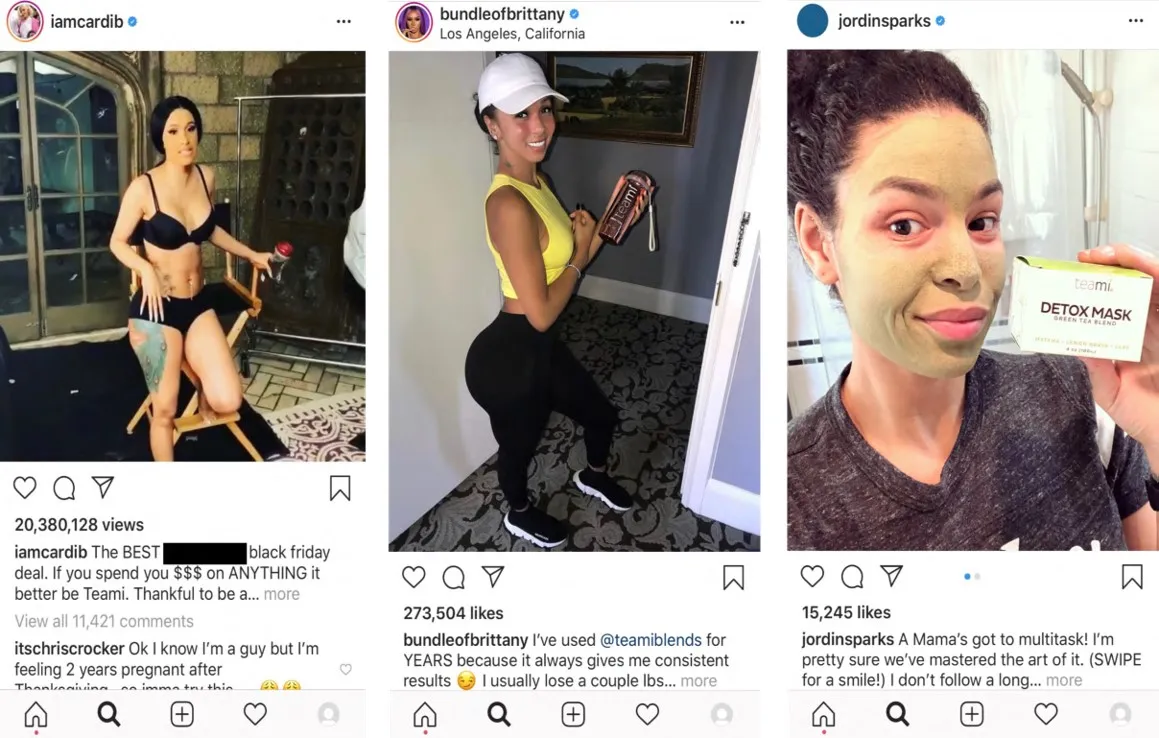
Strong UGC creators bring more to the table than good lighting or trendy edits. They understand what makes content feel authentic, perform under pressure, and align with your brand messaging, without needing a full production team behind them.
Let's see what separates strong creators from the rest:
You’ll see the difference when you're working with the right creators. UGC creators like @whatwouldfallonwear, @kamailecarissa, and @danibobstudios have partnered with inBeat Agency on client campaigns where the content looked good, and more importantly, it performed.
Pro tip: Don’t hire based on visuals alone. Look for UGC creators who understand how content works inside a marketing funnel and how to make branded posts feel human. That’s what drives real results.
So now that you know what makes a great UGC creator, let’s talk about how to actually work with them.
One of the simplest ways to find UGC creators is through dedicated content platforms and creator marketplaces. Sites like Collabstr, UGC Shop, and Brand Meets Creators let you browse talent by niche, content style, or platform, whether you need TikTok videos, Instagram Reels, or product reviews.
These platforms are great for small-scale testing or one-off brand collaborations. You’ll see portfolios, pricing, turnaround times, and sometimes even engagement metrics, all in one place. It’s fast and convenient, especially if your team is short on time or resources.
But here’s the catch: quality control and brand alignment can be hit or miss. If your content strategy requires tighter creative direction or specific usage rights, this route may need more oversight from your team.
Some of the most impactful UGC doesn’t come from influencers but from people already inside your brand. Customers and employees can create authentic content that hits harder than a polished ad.
And when it’s done right, it feels real, relatable, and trustworthy.
Take Sanofi, for example. One of their product managers, Lana, recorded a simple, self-shot video sharing how a young patient’s story keeps her motivated at work. The employer brand team later edited and distributed the clip, but it was Lana’s honest, unscripted storytelling that made the video resonate.
That single piece of content became part of a larger UGC initiative that reached over 14 million people and drove a 66% increase in career site visits.
This kind of employee storytelling works because audiences connect with people instead of logos. In fact, 72% of consumers say they feel more connected to a brand when its employees share content online. It humanizes the message and makes your brand more believable.
Here’s how you make this approach work:
With the right support, employee voices can become your strongest content assets, and they bring a level of trust no polished campaign can match.
Sometimes your best content already exists, sitting in tagged posts, product reviews, and story mentions. With proper usage rights, you can turn this organic social media UGC into scroll-stopping brand assets. It works especially well for beauty products, DTC campaigns, or customer testimonials.
Just be sure to get written permission and align it with your brand messaging before plugging it into paid ads, landing pages, or digital signage.
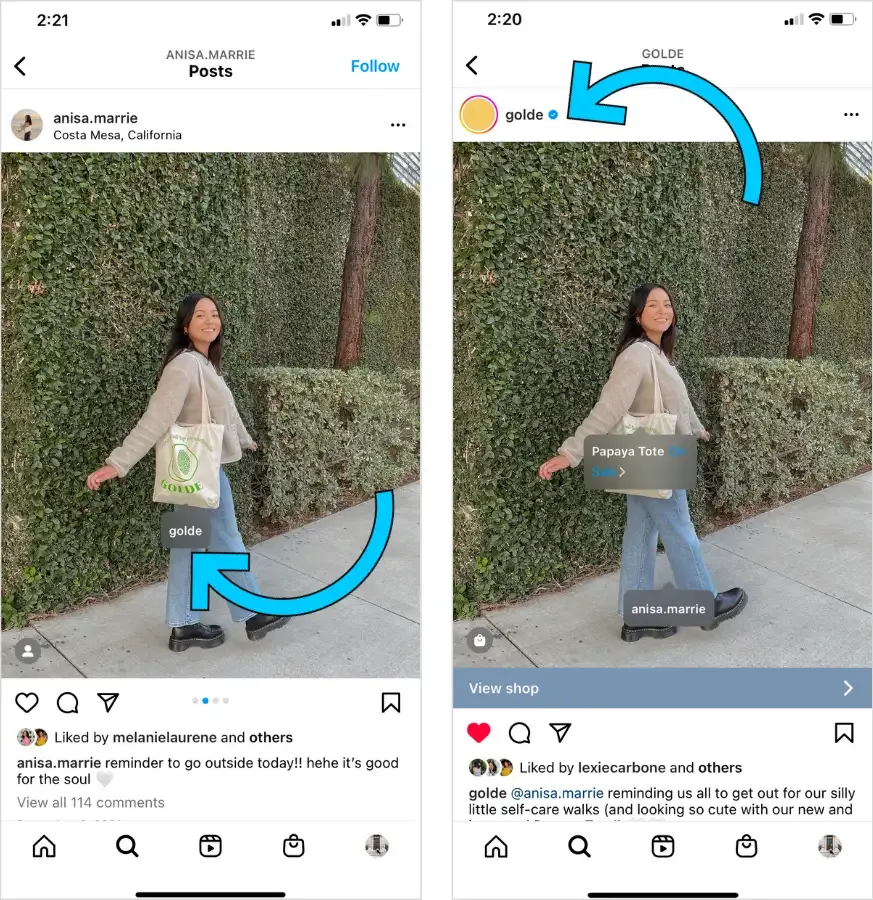
If you need UGC at scale, handling everything in-house can slow you down. From managing briefs and revisions to negotiating usage rights and reviewing content styles, the workload adds up quickly, especially when you are handling multiple campaigns.
That’s where UGC agencies come in. They offer end-to-end support: sourcing creators, overseeing content production, and ensuring the final output aligns with your brand image and content strategy.
Need help finding the right fit? Check out this list: Top 15 UGC Agencies to Leverage Creative Content.
On average, UGC creators charge between $150 and $300 per video. However, rates vary depending on the region, creator’s experience, deliverables, and whether you need extended usage rights or edits for specific platforms.
Below is a quick breakdown of the rates:
If you know how to tell a story, follow a creative brief, and film with intention, even on your phone, you can become a high-performing UGC creator.
The following step-by-step guide will help you build the right foundation, create content that brands actually want, and position yourself for long-term success in the UGC industry.
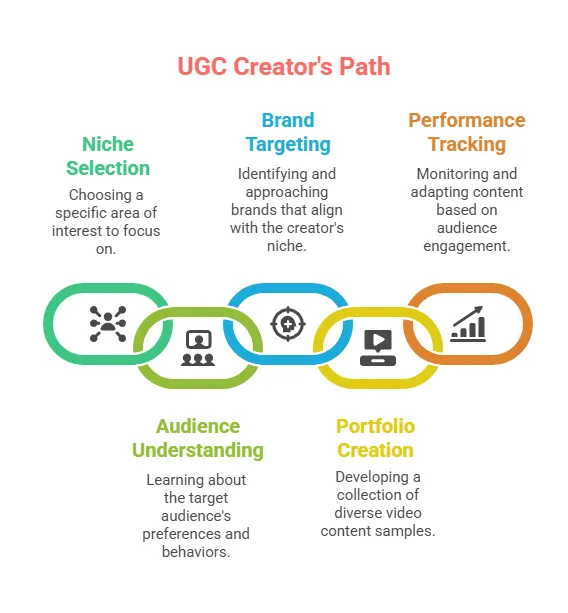
Start with what you actually enjoy or understand. Whether it’s skincare, tech, fashion, fitness, or even SaaS, brands want creators who can speak their language. A clear niche helps you stand out and makes it easier for brands to imagine you in their campaigns.
You don’t need to limit yourself forever, but having a focus upfront helps build your content portfolio and attract the right brand partnerships.
Just look at Diana Lee Zadlo, a UGC creator who leans into her love for food, recipe videos, and culture-focused content.
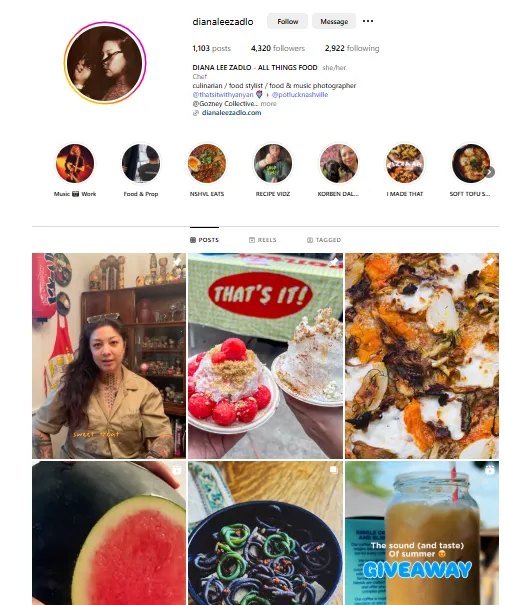
Before you hit record, it’s important to know who you’re speaking to and what content actually performs. Look at what’s trending in your niche, watch how people react to product demos, voiceovers, or casual “day-in-the-life” clips. Are people responding to quick demos? Voiceovers? Problem-solution storytelling?
Pay attention to comment sections, trending hooks, and what gets shared on TikTok or Instagram Reels. The better you understand what converts, the easier it is to create content that brands want to repurpose in their digital marketing.
Remember, the goal isn’t to copy but to understand what makes people stop scrolling. This insight helps you create UGC that connects and supports a brand’s content strategy from day one.
Look for brands already investing in UGC, those running creator ads, posting video testimonials, or partnering with micro-influencers. Check what kind of content they’re using and where it’s showing up.
Focus on products you’d actually use or understand, because that shows in the content. A solid brand fit makes your pitch stronger and your UGC feel less like sponsored content, more like a natural extension of their brand messaging.
Pro tip: Use platforms like TikTok Creator Marketplace, Brand Meets Creators, and Collabstr to discover which brands are actively working with creators and how they’re briefing them.
Don’t wait for brands to come to you; start by making 5–10 solid video samples that show what you can do. Cover key formats like tutorials, testimonials, unboxings, voiceovers, and problem-solution hooks.
Use products you already own. Keep it clean, real, and performance-minded. Brands want to see how your content will look in their paid ads, not your personal aesthetic.
Pro tip: Drop everything into a clean Drive folder or Notion page. Make it frictionless to view and easy to share.
Every piece of content teaches you something. Watch which videos get views, saves, comments, or shares. Pay attention to your engagement metrics instead of likes.
Over time, you’ll start to see patterns, what hooks grab attention, which formats keep people watching, and what drives action. Use that insight to adapt your style and lean into ad-friendly formats that brands actually use in campaigns.
Pro tip: Use tools like TikTok Analytics and Instagram Insights to spot what’s getting traction.
UGC creators have reshaped how brands connect with people through content that feels real, drives action, and doesn’t require massive budgets. If you want to make your content strategy more agile and performance-driven, working with the right creators is one of the smartest moves you can make.
Key takeaways
If you’re looking to scale creator content without sacrificing quality or burning out your team, inBeat Agency can help. Their team connects you with high-performing UGC creators, manages content production end to end, and enables you to launch creator-driven campaigns that actually convert.
Do UGC creators get paid?
Yes. UGC creators are typically paid per video, photo set, or content package they deliver to a brand. Rates vary based on experience, niche, deliverables, and usage rights, but most earn between $150 and $300 per video. Unlike influencers, they don’t get paid for reach; they’re paid for content production.
How do you know if a UGC creator is a good fit for your brand?
Look for someone who understands your target audience and can communicate with authenticity. You can DIY this process or partner with UGC experts like inBeat, who pre-vet creators for tone, niche fit, and content quality.
What does UGC stand for?
UGC stands for user-generated content. It refers to content created by real people, like customers or paid creators, that brands use in their marketing. This includes product reviews, unboxing videos, testimonials, and casual how-to videos shared across social media or in ads.
How do I sell myself as a UGC creator?
Start with a focused niche and build a simple portfolio with 5–10 short-form videos. Showcase content styles like tutorials, testimonials, or voiceovers. Then pitch brands directly or use platforms like UGC Shop or TikTok Creator Marketplace. Show your ability to follow a creative brief, create authentic content, and understand ad-friendly formats.
How many followers do you need to become a UGC creator?
Zero. UGC creators don’t need a large following at all. Unlike influencers, they’re hired for content production, not for posting to an audience. Brands use UGC across their own channels, which means your content performance matters more than your follower count.
How can I find UGC creators?
You can reach out to creators directly on social platforms or use UGC platforms to source talent. But for consistent quality and legal peace of mind, it’s smarter to work with expert UGC agencies like inBeat, which handle vetting, briefs, and delivery at scale.
What is an example of UGC?
A short video showing someone unboxing a product and casually explaining how they use it is a classic example of user-generated content. It feels raw and unscripted but still delivers the brand’s key message, perfect for TikTok, Instagram Reels, or landing pages.
